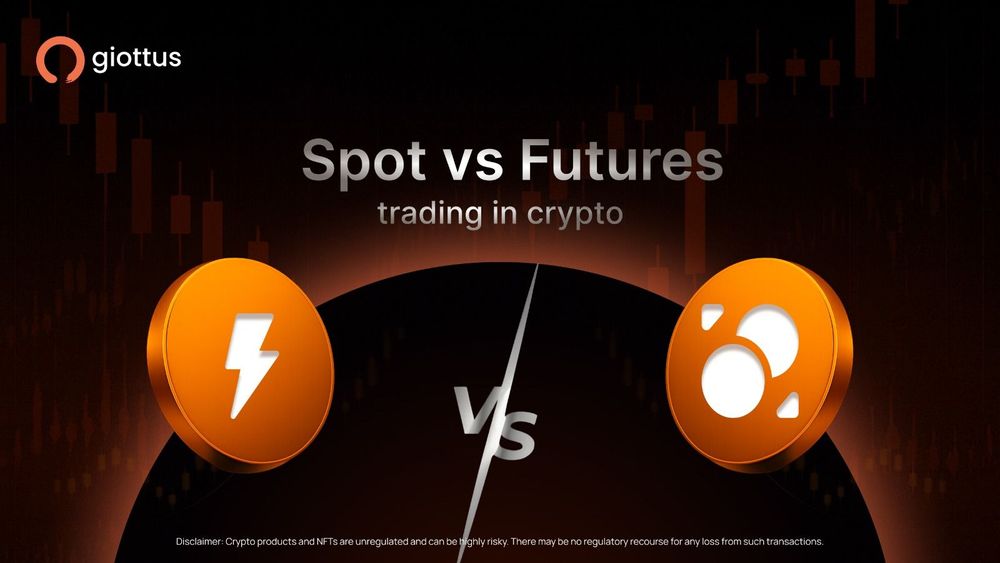Spot vs. Futures Trading in Crypto: All You Need to Know

Crypto assets have surged in popularity over the past decade, evolving from a niche interest into a mainstream financial topic.
Today, crypto isn’t just limited to trading and investing — it has woven itself into everyday culture through NFTs, memes, gaming, and even digital art.
As more people engage with digital assets, understanding how to trade them becomes essential.
Two of the most common trading methods in the crypto world are spot trading and futures trading.
Both allow participation in the market, but they differ significantly in terms of structure, risk, and strategy.
What is spot trading?
Spot trading is the simplest and most common method of trading crypto assets. In a spot trade, you buy or sell a cryptocurrency at its current market price, known as the "spot" price.
Once the transaction is complete, you actually own the asset, whether it's Bitcoin (BTC), Ethereum (ETH), or any other token.
The goal is straightforward: buy at a low price and sell at a higher one to earn a profit.
Since there’s no borrowing or leverage involved, you can only lose what you’ve invested, making it relatively safe.
Spot trading is often favoured by long-term investors and those looking to gradually build a crypto portfolio.
What is Futures Trading?
Futures trading is a more advanced strategy where traders speculate on the future price of a cryptocurrency without owning the actual asset.
Instead of buying the crypto itself, you enter into a contract that tracks its price.
These contracts especially perpetual futures don’t have an expiry date and can be held indefinitely.
One of the biggest advantages of futures trading is the ability to trade in both directions. You can:
- Go long (buy) if you believe the price will rise
- Go short (sell) if you expect the price to fall
Futures also involve leverage, allowing you to open large positions using relatively small capital.
For example, with 10x leverage, you can control a ₹1,00,000 trade with just ₹10,000. While this can boost your profits, it also increases risk. If the market moves against your position, you may face liquidation, meaning your position will be automatically closed, and you could lose your margin.
In addition to regular trading fees, futures contracts often include funding fees, which are periodic payments between traders to maintain the balance between long and short positions.
Also read: Beginner’s Guide to Crypto Futures Trading: Everything You Need to Know
Main Differences Between Spot and Futures Trading
The biggest difference is ownership: spot trading gives you actual control of the crypto asset, whereas futures trading is purely contractual. Spot trading is limited to buying low and selling high, while futures allow you to trade both rising and falling markets.
Risk is another key factor. Spot trading carries lower risk since you can’t lose more than what you put in. In contrast, futures trading is high-risk, especially with leverage involved. It requires careful monitoring, discipline, and a strong understanding of the market.
Spot trading is simple and best suited for long-term holders or conservative investors.
Futures trading is designed for short-term strategies like speculation, arbitrage, and hedging, and is generally used by more experienced traders.
Use Case: Spot vs. Futures in Action
Let’s say a trader believes that Bitcoin’s price — currently at ₹25,00,000 — will rise over the next few months.
- With spot trading, they buy 0.1 BTC for ₹2,50,000 and hold it. If BTC rises to ₹30,00,000, their 0.1 BTC is now worth ₹3,00,000 — earning them ₹50,000 in profit.
- With futures trading, they open a long position worth ₹2,50,000 using just ₹25,000 in margin (10x leverage). If BTC rises 20%, their position also increases in value by ₹50,000 — giving them a 200% return on their capital. But if the market drops by just 10%, they risk being fully liquidated and losing the ₹25,000.
Who Should Use Which?
Spot trading is ideal for:
- Beginners in the crypto space
- Long-term holders or “HODLers”
- Passive investors who don’t track prices daily
- Those looking to build wealth steadily with less risk
Futures trading is better suited for:
- Experienced traders familiar with leverage and market volatility
- Short-term speculators seeking quick profits
- Those who trade between price gaps or reduce risk
- Professionals with strong risk management skills
Conclusion
Choosing between spot and futures trading depends on your goals, risk tolerance, and level of experience. If you're just starting out or prefer a safer, long-term approach, spot trading is likely the better option.
However, if you're more experienced, comfortable with risk, and actively watch the markets, futures trading offers a more dynamic way to profit — especially in volatile conditions.
Understanding the difference between the two is essential. Each has its role in the crypto ecosystem, and with the right knowledge and strategy, you can choose the one that aligns with your financial goals.
Updated on: 23rd September, 2025 5:17 PM